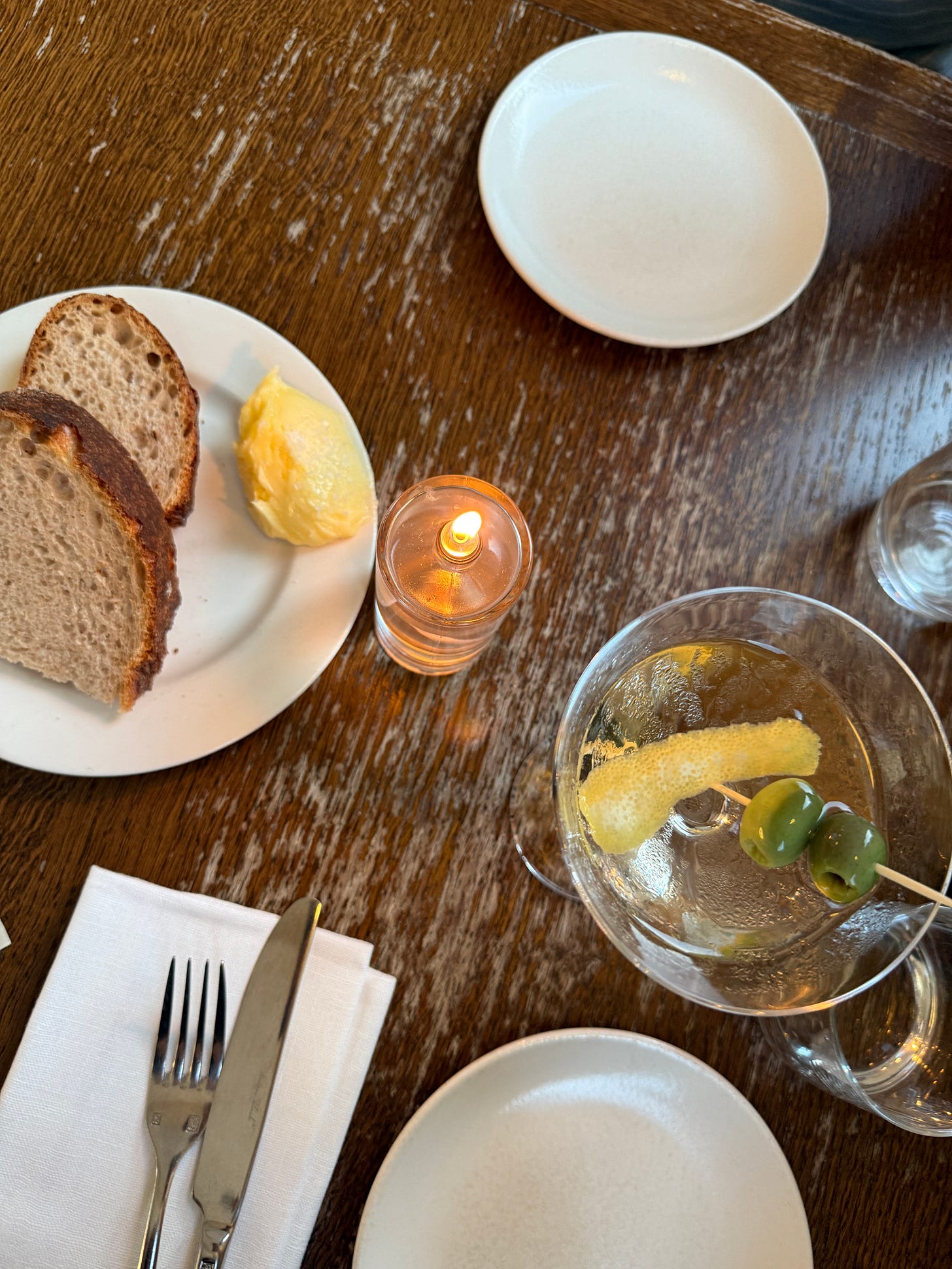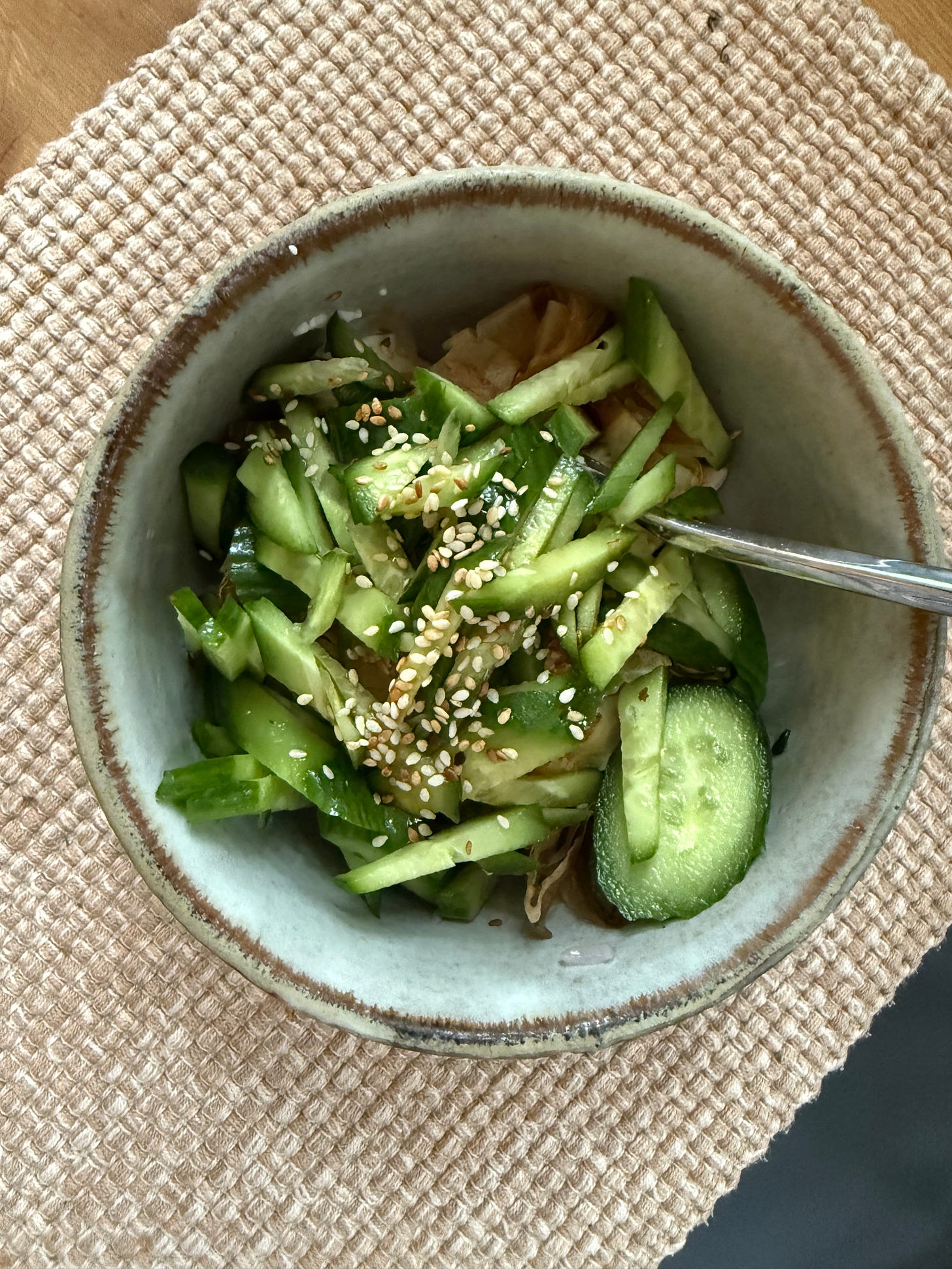Thanks all for reading and hope that you are all enjoying the summer! I love the slow pace of summer, but this year is so hot. As determinedly as I avoid the mugginess of Japanese summers, I seem to be flying from heat wave into heat wave.
Because one of these heat waves was spent in London (where ice and AC were in short supply: in the cab, in the theaters, and even in the [American-branded] hotel), I basked in the AC of my office building and struggled in the off-hours to find something palatable. Having planned the several days around theater tickets (My Neighbor Totoro and Fiddler on the Roof, as culturally appropriate for us1), this ended up being watermelon chunks from the supermarket and green juice. In hindsight, I could have found cold udon from Marugame Seimen (although I haven’t even been to their Japan locations) or naengymeon at one of these spots, but my brain was literally fried.
My friend2 did book an amazing dinner at The Baring though - behold this beautiful martini
Back in Brooklyn, we were welcomed by the chilly whoosh of the AC in the airport, but quickly realized we were in an even hotter heat wave. Nevertheless, we found ourselves in Williamsburg for yet another apartment viewing (still a no). Dizzy from the heat, we wandered into Shalom Japan for a drink, which turned into a meal of chilled asparagus, karaage (theirs is the best), and a bowl of ramen noodles swathed in soy milk and tahini after a friend decided to join us.
These noodles were such an inspiration: imagine combining cold slippery noodles, protein, and fiber all in one quick dish. I decided to incorporate a version into my own summer rotation and did so the next day.
Cold tofu noodles with cucumber pickles
While Shalom Japan’s full version can be found in their cookbook (along with their karaage), this is my pared down dish. When the heat is too much to even boil noodles, I would suggest just rinsing off narrow shirataki noodles (I often cut standard wheat noodles with these anyway, to keep the dish lighter). I also throw together a quick cucumber pickle to get the tang of naengmyeon.
INTO THE BLENDER: 1/2 block tofu (firm) or 1 block for silken, 1.5 tablespoons tahini (or to taste), 1-2 tablespoons mentsuyu (to taste, every brand is different), and enough water to thin it out into a thickness of your liking. I also throw in a knob of ginger if I have it, and skip it when I don’t.
FOR CUCUMBER PICKLES: thinly slice 1 English cucumber (or 3-4 Persian cucumbers) (I use a benriner), add 1/2 teaspoon salt and a squeeze of sweetener (1 tsp of maple syrup, honey, or sugar). Add 1-2 tablespoons of rice/apple cider vinegar to taste. Let sit in the fridge.
Boil the quantity of noodles that suits your appetite (I use soba or somen) and chill in cold water. Transfer to a bowl with ice cubes and as much of the tofu-tahini sauce that you would like.
Here, I add whatever else is in my fridge: Romaine lettuce, natto, arugula, edamame, or even some flakes of grilled fish. At Shalom Japan they added mushrooms stir fried and seasoned with soy sauce. I can see watermelon and tomato working here too.
Eat.
Also though, for the days that all of this is too much, just make hiyayakko: silken tofu in a bowl topped with bonito flake and soy sauce, with grated ginger and sliced cucumber if you can be bothered. For the protein heads, 100 calories of silken tofu (a complete protein) is 10 grams of protein.
But tofu is really not just about the nutrition, and is so delicious, especially when fresh. My parents say that when they were young, they would run out to buy freshly made tofu from the tofu peddler, who came daily (this is also depicted in Koreeda’s Asura on Netflix) and hiyayakko (and its winter equivalent in which the tofu is gently poached - yudofu) are Japanese delicacies3.
You can also just boil somen4, chill it in an ice bath, and dip it in mentsuyu, grated ginger, shiso, and wasabi. This preparation is such a classic that nagashi somen, or putting the noodles in a conveyer belt of sorts to make them more fun to eat is a way that it can be served. This, watermelon, and kakigori are how Japan survives its summers.
The tofu is hidden beneath the slices of cucumber, but this is just silken tofu, sliced cucumber, bonito flake, shoyu, and sesame.
For people who do not default automatically to cold noodles: what do you eat when it is too hot to think and to cook?
A trip to Bath
We also squeezed in a trip to Bath (pre-heat wave) that was so beautiful that I already booked a return trip next month with Michiko. Having realized that I forget the details of what I liked and didn’t like and lose all of my notes that are scattered throughout notebooks and apps, some notes from this trip (that I have also Instagrammed @naranomatcha , if you would like to follow along):
Stayed at Dukes Hotel and added on breakfast. I understand the argument against hotel breakfasts but so relaxing to be able to be served some tea and coffee. Also how cute is this butter.
I couldn’t decide where to book afternoon tea, but am so glad I did so at Royal Crescent Hotel. The garden is so beautiful and filled with lavender and close to Royal Crescent and the Botanical Gardens for a post-tea stroll.
Bath Abbey and do the tour up to the top.
Logistically, we took a train in following our red-eye flight into LHR, which felt like the right move. Next time, I’ll squeeze in a museum and tea overlooking the water. How pretty is this? I’ll also book a dinner - I ended up scrambling for a reservations and not liking where I ended up. Marlborough Tavern looks great.
Both productions are 10/10 go see them.
And her book, Ghost Chili, is as good as her taste in restaurants
An excerpt from Hiromi Kawakami’s Strange Weather in Tokyo:
“Here you are, hiya-yakko,” Satoru said as Sensei took the bowl he passed over the counter. Sensei carefully doused it with soy sauce. Gently, he picked some of the tofu with his chopsticks and brought it to his lips.
“It’s tasty,” Sensei said straightaway, facing me. Without any greeting or introduction, he spoke as if continuing a conversation we had been having all along.
“I ate some earlier myself,” I said, and Sensei nodded lightly.
“Tofu is quite special.”
“Yes.”
“It’s good warm. It’s good chilled. It’s good boiled. It’s good fried. It’s versatile,” Sensei said readily, taking a sip from the small sake cup.
Nara is known for Miwa Somen, which is even thinner and more delicate than the already-thin standard somens. The thinnest Miwa somen are a delicacy and are commonly given as ochugen, or gifts of appreciation. Rice Factory stocks some Miwa somen, if you are curious to try, but I imagine that for the very thinnest, you will need to travel to Nara :)









